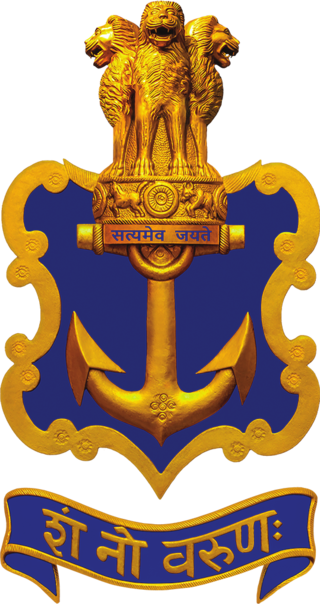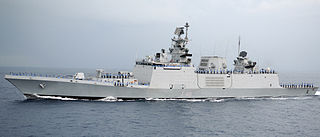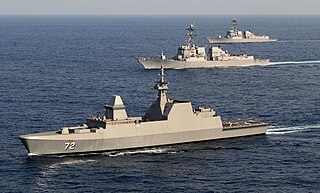
The Indian Navy is the maritime branch of the Indian Armed Forces. The President of India is the Supreme Commander of the Indian Navy. The Chief of Naval Staff, a four-star admiral, commands the navy. As a blue-water navy, it operates significantly in the Persian Gulf Region, the Horn of Africa, the Strait of Malacca, and routinely conducts anti-piracy operations and partners with other navies in the region. It also conducts routine two to three month-long deployments in the South and East China seas as well as in the western Mediterranean sea simultaneously.
The Rim of the Pacific Exercise (RIMPAC) is the world's largest international maritime warfare exercise. RIMPAC is held biennially during June and July of even-numbered years from Honolulu, Hawaii, with the exception of 2020 where it was held in August. It is hosted and administered by the United States Navy's Indo-Pacific Command, headquartered at Pearl Harbor, in conjunction with the Marine Corps, the Coast Guard, and Hawaii National Guard forces under the control of the Governor of Hawaii.

USS Carney (DDG-64) is the 14th Arleigh Burke-class destroyer in the United States Navy. The guided-missile destroyer is the first to be named after Admiral Robert Carney, who served as Chief of Naval Operations during the Eisenhower administration.

INS Delhi is the lead ship of her class of guided-missile destroyers of the Indian Navy. She was built at the Mazagon Dock Limited in Mumbai and commissioned on 15 November 1997. This class is among the largest warships to be designed and built in India.

USS Fife (DD-991), a Spruance-class destroyer, was a ship of the United States Navy named for Admiral James Fife, Jr. (1897–1975), a distinguished Submarine Force commander during World War II.

INS Tabar (F44) is the third of the Talwar-class frigate of the Indian Navy. The frigate was built by Baltiyskiy Zavod in St. Petersburg, Russia. The frigate was commissioned on 19 April 2004 in Kaliningrad, Russia with Captain Biswajit Dasgupta. As of August 2024, the current Commanding Officer (CO) of INS Tabar is Captain MR Harish.

The Shivalik class or Project 17 class is a class of multi-role frigates in service with the Indian Navy. They are the first warships designed with low observability features built in India. They were designed to have better stealth features and land-attack capabilities than the preceding Talwar-class frigates. A total of three ships were built between 2000 and 2010, and all three were in commission by 2012.

The annually held Varuna naval exercise is an integral part of France–India strategic relationship in the 21st century and consists of naval cooperation drills between the French Navy and the Indian Navy. The joint-exercises are held either in the Indian Ocean or Mediterranean Sea with the aim of improving Indo-French coordination on capabilities like cross-deck operations, replenishment-at-sea, minesweeping, anti-submarine warfare and information sharing. It was first started in 1983, though given its present name in 2001. France is Littoral State of the Indian Ocean through the French Overseas region of Réunion, Mayotte and Scattered Islands in the Indian Ocean.

INS Shivalik (F47) is the lead ship of her class of stealth multi-role frigates built for the Indian Navy. She is the first stealth warship built by India. She was built at the Mazagon Dock Limited (MDL) located in Mumbai. Construction of the vessel began in 2001 and was completed by 2009. She underwent sea trials from thereon before being commissioned on 29 April 2010.

RSS Stalwart (72) is the fifth ship of the Formidable-class stealth frigate of the Republic of Singapore Navy.

INS Kora is the lead ship of the Kora-Class of 1,350-tonne guided missile Corvettes in active service with the Indian Navy. The vessel was built at Garden Reach Shipbuilders and Engineers (GRSE) and outfitted at Mazagon Dock Limited (MDL).

INS Kulish is a Kora-class corvette, currently in active service with the Indian Navy. She was ordered in October 1994, and the keel was laid in October 1995. The ship was launched in August 1997 and was commissioned on 20 August 2001.

INS Karmuk is a Kora-class corvette, currently in active service with the Indian Navy.

Carrier Strike Group Seven 2007–09 operations included two deployments to the U.S. Fifth Fleet, and its embarked Carrier Air Wing Fourteen flew 2750 air sorties in support of ground forces in Iraq and Afghanistan while CARSTRKGRU-7 surface warships supported theater security and maritime interdiction operation within that fleet's area of responsibility. CARSTRKGRU-7 also made a Western Pacific surge deployment in place of Carrier Strike Group Five.

INS Shakti (A57) is a Deepak-class fleet tanker in service with the Indian Navy. She was built by Fincantieri, an Italian shipbuilding company based in Trieste. She is the second and final ship of her class. Shakti, along with her predecessor Deepak, is one of the largest ships of the Indian Navy.

INS Jyoti (A58) is the third of four Komandarm Fedko-class replenishment oilers. She was modified for naval use and is now being operated by the Eastern Naval Command of the Indian Navy. Jyoti was the largest ship in the navy until INS Vikramaditya (R33) was commissioned in November 2013. It is the third largest ship in the Indian Navy after the aircraft carriers INS Vikrant and INS Vikramaditya. Its primary role is fleet replenishment and sustaining blue-water operations. It was later fitted with close-in weapon systems for self-defence.

Singapore India Maritime Bilateral Exercise (SIMBEX) is an annual bilateral naval exercise conducted by the Indian Navy and the Republic of Singapore Navy (RSN).

Theatre Level Operational Readiness Exercise (TROPEX) is an inter-service military exercise involving the participation of the Indian Army, Air Force, Navy and the Coast Guard. The exercise generally commences at the beginning of each year and lasts a month. It is generally carried out in three phrases: independent workup phase, joint workup phase and tactical phase.
HSwMS Hälsingland (Hgd), was the second submarine of the Västergötland class. The vessel was named after Hälsingland, Sweden. The submarine was launched on 31 August 1987 and entered service with the Swedish Navy on 20 October 1988. Hälsingland served with the Swedish Navy until 1997 when the submarine was decommissioned. In 2005 Hälsingland and sister boat HSwMS Västergötland were sold to Singapore, where Hälsingland was renamed RSS Archer and entered service on 2 December 2011. Archer remains in service.
Maritime Partnership Exercise (MPX) is a multilateral event conducted by Indian Navy in which naval forces of foreign countries participate. This exercise is conducted as part of the Indian Navy's ongoing efforts to enhance its operational capabilities and strengthen its partnerships with friendly nations. MPX underscores India's commitment to promoting regional stability and security.


















